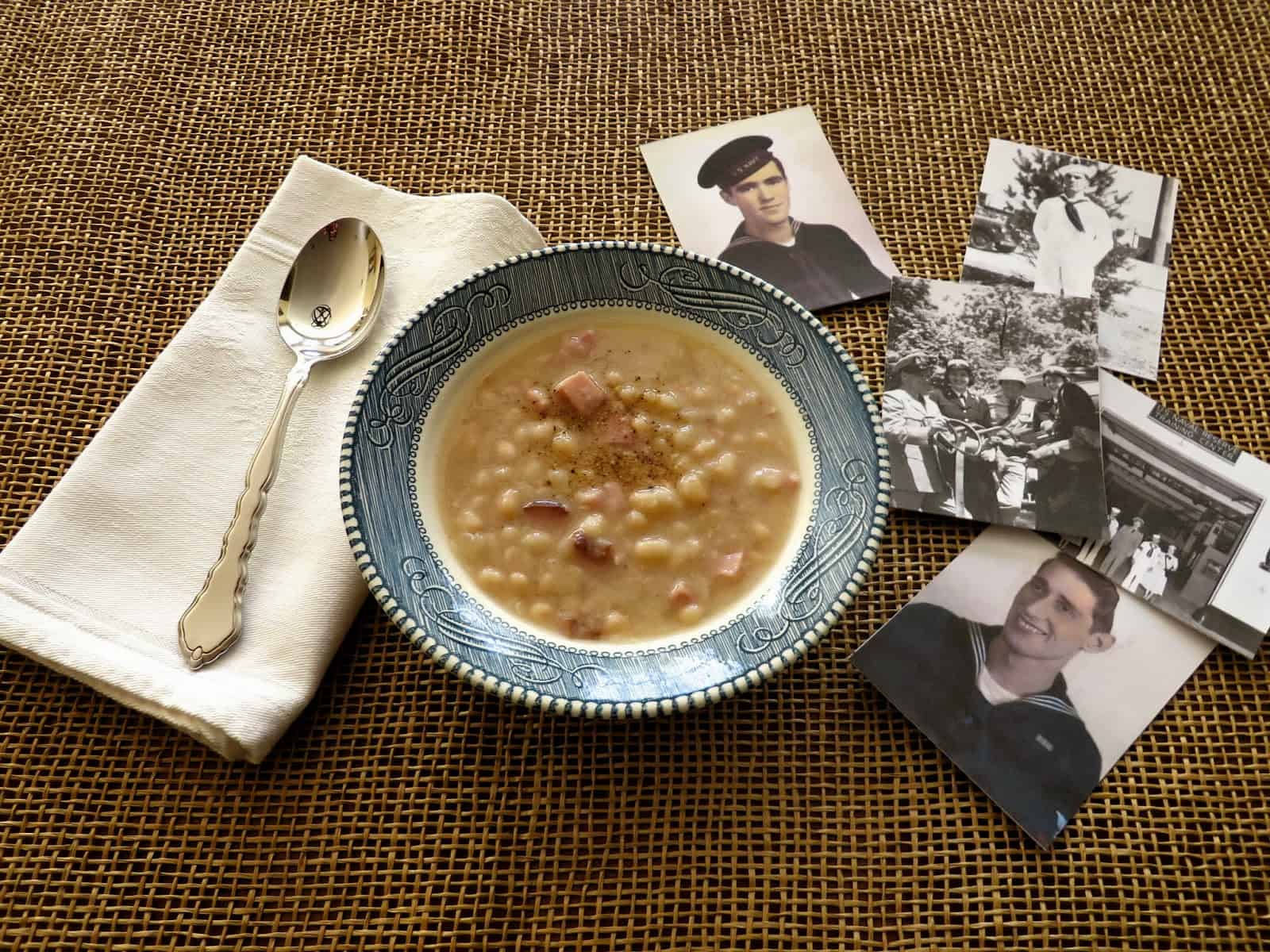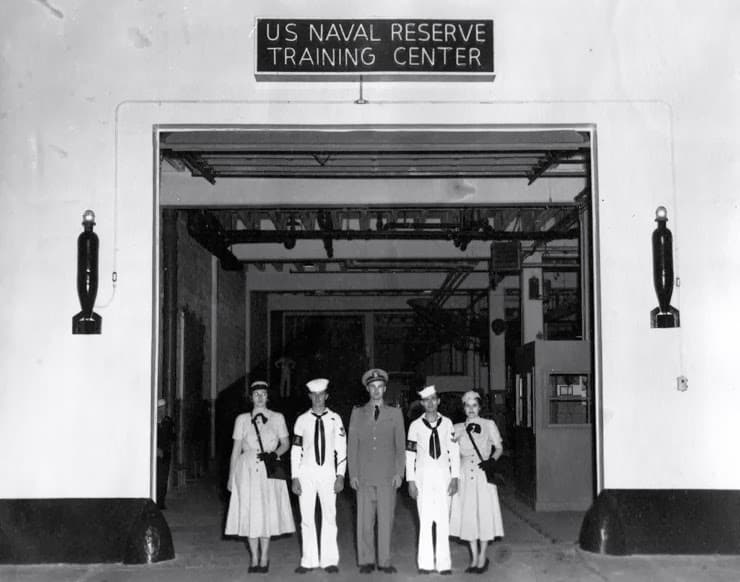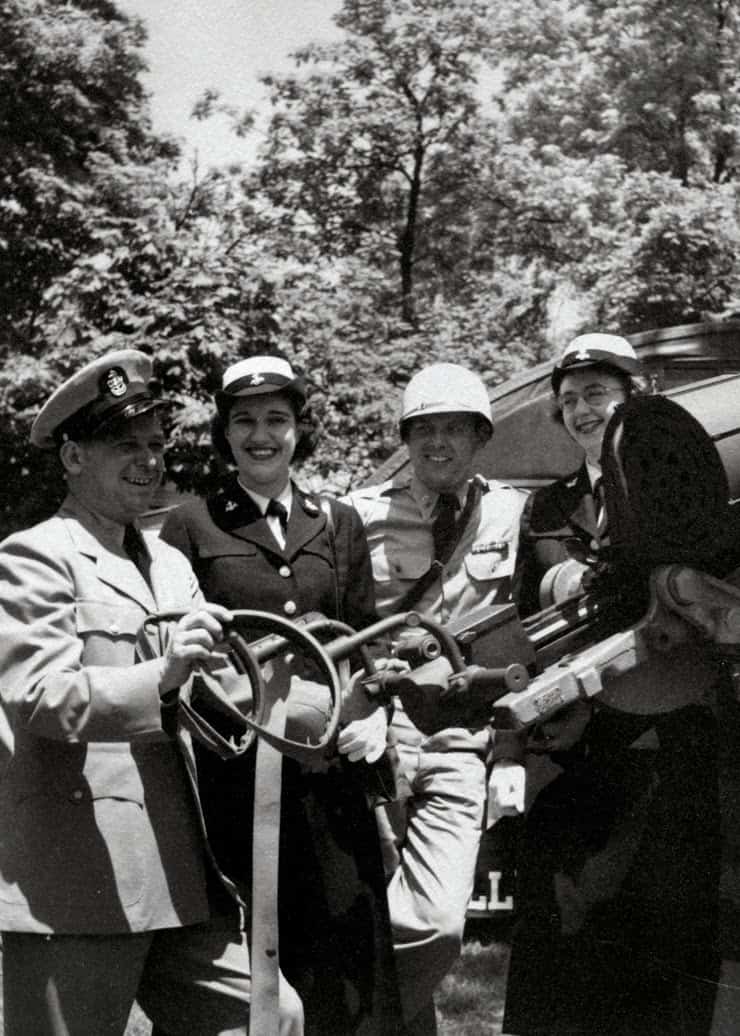One of Aunt Betty’s signature dishes was Navy Bean Soup. This hearty soup is simple to make and quite practical. Inexpensive but tasty, it can be made ahead and left to simmer as guests arrive or family gathers. That gave Aunt Betty ample opportunity to make everyone feel welcome as she exercised her gift of hospitality.

Correcting the Record
Wouldn’t you know it? I got it all wrong!
Not long ago I received an unexpected email from my cousin. The subject line read “Newspaper Article I Found in Grandma’s Bible.” Attached was a photo of an article from the Courier-Journal on yellowed newsprint. It was four columns wide and included a photo of two women. One of them was our Aunt Betty.
The year of publication was 1950. The headline read “In Love With The Army, Two Girls Recruit for Navy. The article, by Nancy Grace, told of “two Louisville girls” who worked as secretaries for Army officers at the Jeffersonville Quartermaster Depot. Though happy to work for the army, these two young women, my aunt and her friend Marie, joined the US Naval Reserve in pursuit of training and adventure. Apparently, the newspaper felt that was good material for a human interest story. My grandmother agreed and tucked a copy away where she could always find it, between the pages of her Bible.
Army and Navy
In 2013, when I first posted here about Aunt Betty’s service in the WAVES, I had a completely different understanding of her story. At that time I wrote, “In 1942 the US Navy began to enlist women in the WAVES. Aunt Betty, my Dad’s youngest sister, was 23 at the time. With the nation at war and both of her brothers joining the Navy, Aunt Betty felt drawn to do her part and enlisted.”
Even then, I had to admit that I didn’t really know much about Aunt Betty’s time in the service. I’d seen her Navy uniform, now tucked safely away in the cedar chest. I also knew she had worked at the Quartermaster Depot in Jeffersonville, IN. Over the years, many of the anecdotes Aunt Betty shared in conversation began, “When I worked at the Quartermaster Depot….” Still, what I didn’t know was a lot.
At that time I didn’t catch the incongruity of a Navy recruit working at an Army depot. It really didn’t occur to me that these two pieces of my aunt’s history might not mesh seamlessly together. Now it is clearer that I was confused about timing, roles and branches of the service. I had overlooked a detail that revealed an interesting aspect of Aunt Betty’s story.

A Great Find
According to the newspaper, Aunt Betty did begin her career with the armed services in 1942. However, instead of enlisting in the navy at that time, she actually went to work for the army. She was secretary to the chief of the manufacturing division of the Jeffersonville Quartermaster Depot.
What I missed was that Aunt Betty worked for the army eight and a half years before she joined the navy. In 1950 she and another secretary at the Depot joined as seamen recruits in the Wave Reserve. As such, they worked in the Navy recruiting office at Standiford Field on Monday nights in addition to their Day jobs at the Army Depot.
The article says, “When the girls joined the Wave Reserve they were given military leave by the Army and sent to Great Lakes, IL for two weeks of boot camp.” There they trained as the men were trained, with long and challenging daily drills. The training was rough but both women felt it was “ideal” and were “eager to recommend it to other girls.” They also looked forward to the opportunity of active duty. At least two weeks would be required annually, as members of the reserve. “We don’t know just what that will be,” Aunt Betty was quoted as saying, “and that’s what makes it interesting. We always have some new experience to look forward to.”
Figuring Things Out
That newspaper article was a wonderful discovery. At the top of the page was a great photo of Aunt Betty and her fellow recruit in their Wave uniforms, smiling. While these new facts contradict the timeline I had imagined, they confirm other Aunt Betty’s dedication to service and also give me a new perspective on her youthful enthusiasm. I always imagined that Aunt Betty served in the navy during World War 2. Now I know that it wasn’t until later that she proudly wore that Navy Uniform I admired.
As to those conversations that included, “When I worked at the Quartermaster Depot….” I don’t remember much about what followed. Back then, I didn’t have any real understanding of the setting or context. I had little enough idea what a Depot was, let alone a Quartermaster. Instead of the details, what I got from her stories was a sense that Aunt Betty’s service, whether Army or Navy, was a significant aspect of her life. Those experiences shaped the curious, competent and interesting woman I had the privilege to call my aunt. I was delighted by her adventurous spirit and always impressed by her willingness to pitch in for a good cause.

The Next Chapter
The Jeffersonville Quartermaster Depot closed in 1958. At that time Aunt Betty continued her service as a medical secretary at the VA Hospital on Zorn Avenue. It was on the east side of town, not that far from where she grew up. In time she moved back there, to what had been Grandma’s house, the house next door to ours. Aunt Betty retained her sharp wit and excellent secretarial skills and found her work at the hospital interesting. She continued to work there until her retirement in the 1970s.
Though Aunt Betty was not the most avid cook in our family, she always possessed the gift of hospitality. My brother and I were frequent visitors after she moved next door. She was kind and curious and readily welcomed family or friends to her home. She stopped to listen to what we had to say and was always good company. Rather than spending a lot of time in the kitchen, Aunt Betty made her guests feel at home by drawing them into conversation over a cold drink or a cup of coffee.
When she cooked, Aunt Betty preferred recipes she could make ahead and keep warm as her guests arrived. One of her signature creations was Navy Bean Soup. I always thought of that particular dish as having some personal significance, though I may have just imagined it. I don’t have her exact recipe. Instead, this simple recipe is from an old edition of Betty Crocker’s Cookbook, a family favorite.
Navy Bean Soup
Course: Soups, MainCuisine: AmericanDifficulty: Easy7
servings15
minutes1
hour30
minutes1
hourThis hearty soup can be made ahead and left to stay warm on the stovetop as guests arrive or your family gathers.
Ingredients
water
1 pound dried navy or pea beans (about 2 cups)
2 cups diced cooked ham pieces
1 ham bone ( if you have it, don’t worry if you don’t)
1 small onion, finely chopped (about 1/4 cup)
1 bay leaf
Dash of pepper
Directions
- Rinse the beans in a colander. Sort through them carefully to remove any dark beans, small stones or other debris.
- Place the rinsed beans in a 4-quart cooking pot. Add water to cover by about 1-inch. Heat to boiling. Boil for 2 minutes. Remove from heat and cover. Allow to stand for 1 hour.
- Drain the beans and return them to the same pot. Add 7 cups of clean water. Stir in the rest of the ingredients. Bring to a boil. Skim off any foam that forms on the top of the water.
- Reduce heat. Cover and simmer, stirring occasionally, until the beans are tender (1-2 hours). Add water during cooking if necessary.
- Remove bay leaf. Remove hambone, if used. Adjust seasoning to taste, adding a little salt and/or pepper as you like.
- Enjoy!
Notes
- Recipe Source: Adapted from a recipe in our old copy of Betty Crocker’s Cookbook.








nice tie-in! i'm a fan of all beans, and this soup is a favorite. 🙂